Are young people really addicted to smartphones? Are TV lovers still going strong? Diversifying information behaviors
◆How do young people use TVs, computers, and smartphones?
and how they use them
"I don't really understand what today's youth are doing on their smartphones."
"Do young people just play games all the time instead of watching TV?"
Recently, such topics have been frequently discussed and featured in the news.
In recent years, new information and communication services like social media, video sharing platforms, social games, and curated media have been emerging one after another.
At the same time, new devices equipped with screens of various sizes—smartphones, tablets, and more—have become widespread. People use these new services to access video and text information and interact with friends.
As a result, diverse services targeting various screen media—beyond traditional TVs and PCs—have proliferated, dramatically diversifying people's information-seeking behaviors.
Young people are undoubtedly the most affected by the proliferation of these media.
"How do young people differentiate their use of screen media?"
has recently drawn attention from a business perspective as well.
However, analyzing how young people specifically differentiate their use of diverse screen media requires detailed data from large-scale samples, making it difficult to find definitive answers.
◆Unraveling Young People's Information Behavior with Detailed Data
Therefore, DENTSU SOKEN INC. Media Innovation Research Department decided to classify the diverse patterns of screen media usage into distinct categories using Video Research Ltd.'s expanded Media Contact Environment Survey data "MCR/ex" from fiscal year 2014. Two key features unique to this analysis are:
Screen media usage behavior was classified into 12 distinct patterns.
Screen media usage was categorized as: ① "Terrestrial TV viewing" ② "BS/CS satellite TV viewing" ③ "Recorded program playback" ④ "Package media playback (DVD, etc.)" ⑤ "Video game use"; on PCs: ⑥ "Email use" ⑦ "Internet use" ⑧ "SNS use"; and on smartphones, feature phones, and tablets: ⑨ "Email use" ⑩ "Internet use" ⑪ "SNS use" ⑫ "PC/mobile game use".
We redefined weekdays and holidays to understand information behaviors.
It is well known that media contact behaviors differ significantly between weekdays and holidays. Furthermore, in recent years, the diversification of occupations and the expansion of the service industry have led to the emergence of various work patterns, meaning weekends and public holidays are not necessarily days off. Therefore, we attempted to more accurately grasp information behaviors by defining weekdays as "days when the individual worked or attended school for even a short time" and holidays as "days when the individual did not work or attend school at all."
This time, we created media clusters using only the "screen media contact time" of young people (ages 15-29), without considering communication awareness or values whatsoever. We then profiled each cluster.
As a result, we were able to extract a total of 10 clusters from the classification of young people's media contact behavior patterns. We will introduce how young people differentiate their screen media usage through seven of these clusters.
◆Emerging Coexistence: Terrestrial TV Viewing and Other Media Usage
Several clusters revealed that even among young people with diversified screen media usage, terrestrial TV viewing and other media use coexist effectively within their daily lives.
Young people overwhelmingly centered on "terrestrial viewing" remain prevalent.
Approximately 28% of young people engaged in information behaviors centered around "terrestrial viewing," such as the 'Terrestrial-Oriented Female Students' cluster and the 'Terrestrial-Oriented Housewives' cluster.

【Cluster 1】 Terrestrial TV-Oriented Female Students
[Composition Ratio] 5.2%
【Primary Occupation】 High school girls, college women
【Target Characteristics】
・Extremely high terrestrial TV viewing on weekdays and holidays, coupled with very high mobile SNS usage.
・Approximately 70% of the total are female.
・Mobile SNS usage is overwhelmingly the highest among all clusters.
・Often post about TV on SNS or watch TV prompted by SNS.



【Cluster 2】 TerrestrialTV-Oriented Housewives
【Composition Ratio】22.9%
【Primary Occupations】Housewives living with children, office workers in clerical/sales roles
【Target Characteristics】
・Extremely high terrestrial TV viewing on weekdays and holidays, with high mobile internet usage on holidays.
・Approximately 60% are female.
・This is the cluster with the highest marriage rate at 34.2%.
・Television dominates their information-seeking behavior, and they hold positive impressions such as "TV is enjoyable for me."

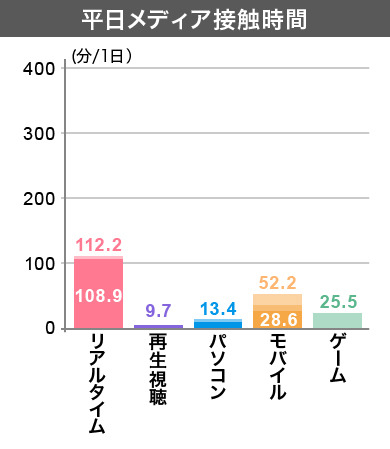

Both clusters watch an average of about 4 hours of terrestrial broadcasts on holidays, showing TV dominates their media consumption. Their other screen media activity mainly involves significant mobile usage time. Even in today's diverse media landscape, young people overwhelmingly centered on "terrestrial viewing" remain strong.
"Recorded playback viewing," "BS/CS satellite viewing," and "packaged media playback viewing" coexist with "terrestrial broadcast viewing."
The three clusters – 'TV Content All-Rounders', 'Multi-Channel Users', and 'Package Marathon Viewers' – are characterized by high terrestrial viewing time combined with significant time spent on 'recorded playback viewing', 'BS/CS satellite viewing', and 'packaged media playback viewing', respectively.
【Cluster 3】TV Content All-Rounder
[Composition Ratio ] 7.5%
【Primary Occupations】Office workers (OLs), retail, food service, healthcare/welfare, etc. – working women with irregular schedules, high school girls, college women
【Target Characteristics】
・High terrestrial TV viewing on weekdays and holidays, with very high recorded playback viewing.
・Women comprise approximately 60% of the total.
・Preferred TV genres range widely from dramas to variety shows.
・High affinity for video content, evidenced by frequent mobile video viewing.

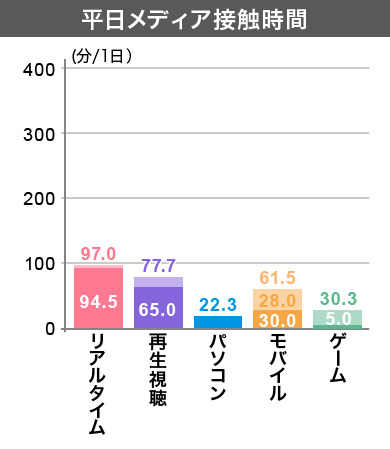
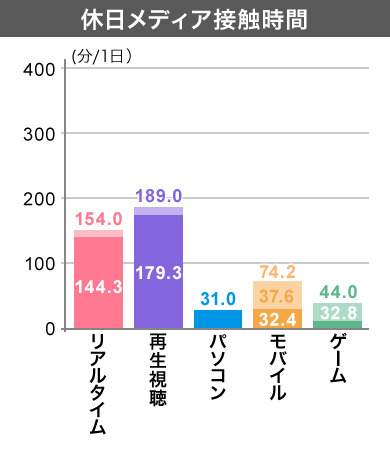
【Cluster 4】 Multi-Channel Users
【Composition Ratio】1.2%
【Primary Occupations】Single male manual laborers, self-employed men, male university students
【Target Characteristics】
・High terrestrial TV viewing and PC internet usage on weekdays and holidays, with exceptionally high BS/CS satellite viewing.
・Approximately 70% are male.
・Preferred TV genres include foreign dramas and movies, baseball, and other programs unique to multi-channel offerings.
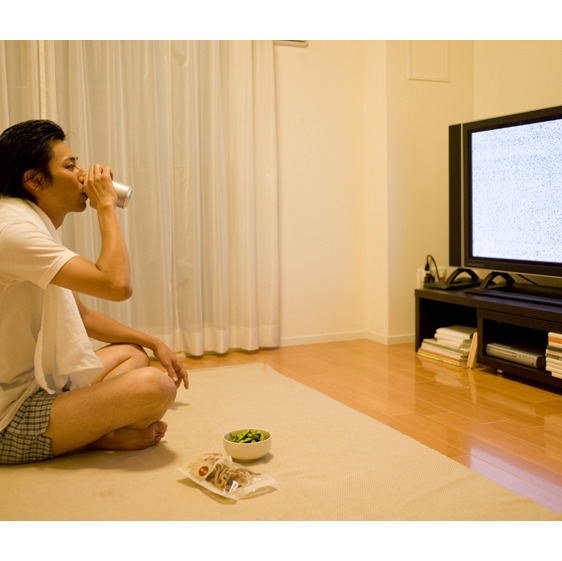
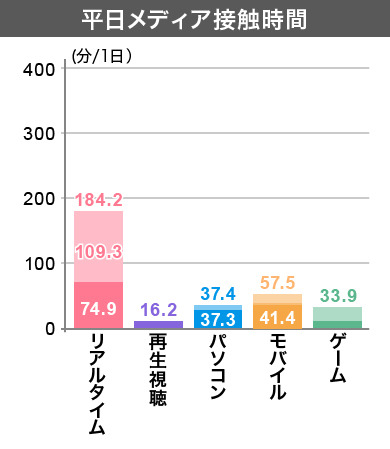
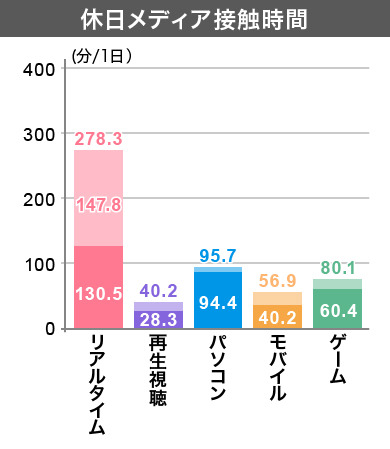
【Cluster 5】 Package Marathon Viewers
【Composition Ratio】1.3%
【Primary Occupations 】Married men living with children, female junior college students, female university students, female graduate students
【Target Characteristics】
・High terrestrial TV viewing on weekdays and holidays, with exceptionally high package playback viewing on holidays.
・Approximately 60% male, 40% female. Approximately 31% are married.
・Frequent packaged media viewing on holidays, either binge-watching movies/shows in marathons or watching together with children.

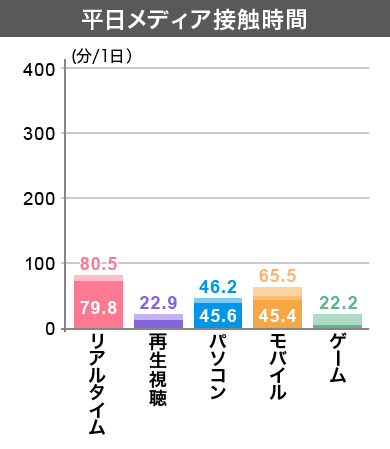
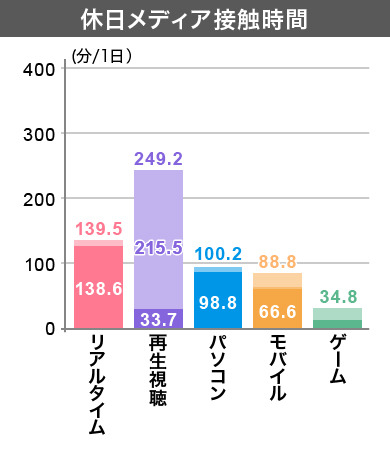
These clusters fundamentally enjoy video content, consuming visual information in a balanced way—including terrestrial TV broadcasts—without favoring any single medium. Therefore, "terrestrial TV viewing" and other video media like "recorded playback viewing," "BS/CS satellite viewing," and "package playback viewing" are not competing but rather coexisting.
"PC/Mobile Gaming" and "Mobile Usage" coexist relatively well with "Terrestrial TV Viewing".
The two clusters, 'Terrestrial TV Coexisting Online Gamers' and '24-Hour Mobile Mail Users', are characterized by relatively high 'terrestrial TV viewing' time, combined with significant 'PC/mobile game usage' and 'mobile email usage' time respectively.
【Cluster 6】 Terrestrial Broadcast Coexisting Online Gamers
[Composition Ratio] 10.6%
【Primary Occupations】Male Business Professionals, Male High School Students, Male College Students
【Target Characteristics】
・High levels of terrestrial TV viewing, PC internet use, and mobile internet use on both weekdays and holidays, with particularly high PC and mobile game usage.
・Approximately 70% of the group are male.
・They frequently play PC online games and social games, and also listen to radio via the internet.

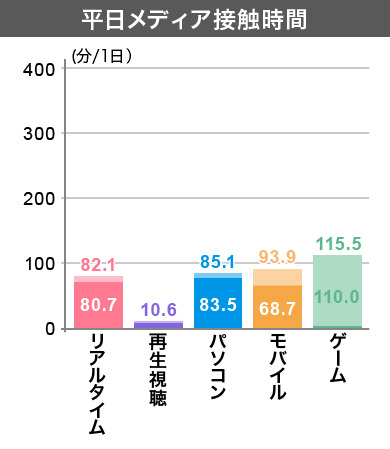

【Cluster 7】 24H Mobile Mailer
【Composition Ratio】1.2%
【Primary Occupations】Female full-time employees in sales/service roles (food service, real estate), healthcare/welfare workers, female university students, female high school students
【Target Characteristics】
・High terrestrial TV viewing on weekdays and holidays, with extremely high mobile email usage.
・Approximately 60% of the total are women.
・Extremely low PC internet usage. Favorite TV genre is foreign dramas.
・Due to their work, they have a high mobile internet usage rate and frequently use mobile email.


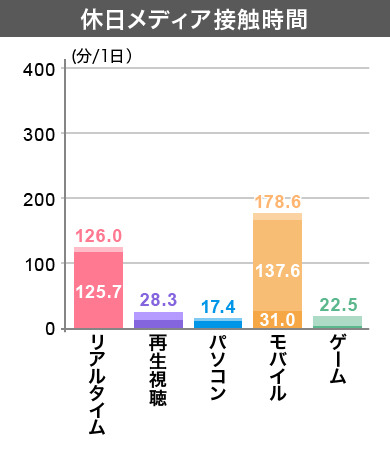
'Terrestrial Broadcast Coexisting Online Gamers' spend roughly equal amounts of time across screen media: "terrestrial broadcast viewing," "PC usage," "mobile usage," and "PC/mobile gaming." They account for about 10% of the youth demographic.
Playing PC/mobile games does not drastically reduce other screen media usage; rather, they balance these activities well. Their roughly 10% share suggests PC/mobile gaming has become a normal part of daily life, confirming it is by no means an uncommon information activity today.
Furthermore, '24H Mobile Mailer' shows very high "mobile email usage," likely due to occupational demands requiring all-day work use. However, for other screen media activities, "terrestrial TV viewing" occupies most of their time. Therefore, it is highly likely that "PC/mobile game usage" and "mobile email usage" can coexist relatively well with "terrestrial TV viewing."
As described above, amidst the growing number of smartphone-dependent youth, the significant discovery was that a substantial 28% of young people remain overwhelmingly centered around "terrestrial TV viewing." Moving forward, it is certain that information behaviors will diversify further, encompassing youth whose lives center around TV, PC, mobile, or games. Precisely because of this, more objective detailed data is needed, and the necessity for calm analysis based on quantitative data may be greater than ever before.
[Screen Media Usage Pattern Profiling Analysis Data]
Video Research Ltd. ACR/ex April-June 2014 Survey Data Used
Survey Areas: 7 regions (Kanto, Kansai, Nagoya, Northern Kyushu, Sapporo, Sendai, Hiroshima)
Analysis Target: Men and women aged 15–29
Analysis Sample Size: Total of 2,333 samples across 7 regions
(Kanto: 967 ss, Kansai: 384 ss, Nagoya: 214 ss, Northern Kyushu: 206 ss, Sapporo: 195 ss, Sendai: 189 ss, Hiroshima: 178 ss)
Question Items:
1.Cluster Classification Items: Utilizing media exposure time from lifestyle behavior (MCR/ex: diary-style survey for a specific week)
2.Profiling Items:
・Basic Profile (Gender, Marital Status, Occupation, Employment Type, Household Income, etc.)
・Daily Life Attitudes/Behaviors (Lifestyle Attitudes, Purchasing Attitudes, Food Attitudes, Leisure Activities, etc.)
・Media/Advertising Engagement/Usage of Each Medium [TV, Radio, Newspapers, Magazines, Transportation, Internet], Usage Attitudes/Advertising Attitudes for Each Medium, etc.
Was this article helpful?
Newsletter registration is here
We select and publish important news every day
For inquiries about this article
Back Numbers
Author

Toru Shono
Dentsu Inc.
Joined Dentsu Inc. in 2001. Worked in sales handling clients such as beverage manufacturers and staffing agencies. Subsequently, conducted consumer trend research on Japanese and Chinese consumers in the marketing section. Currently engaged in research and development related to media, information and communications, and technology. Specializes in research and development focusing on audience insights (consumer information behavior) driven by changes in the media environment.